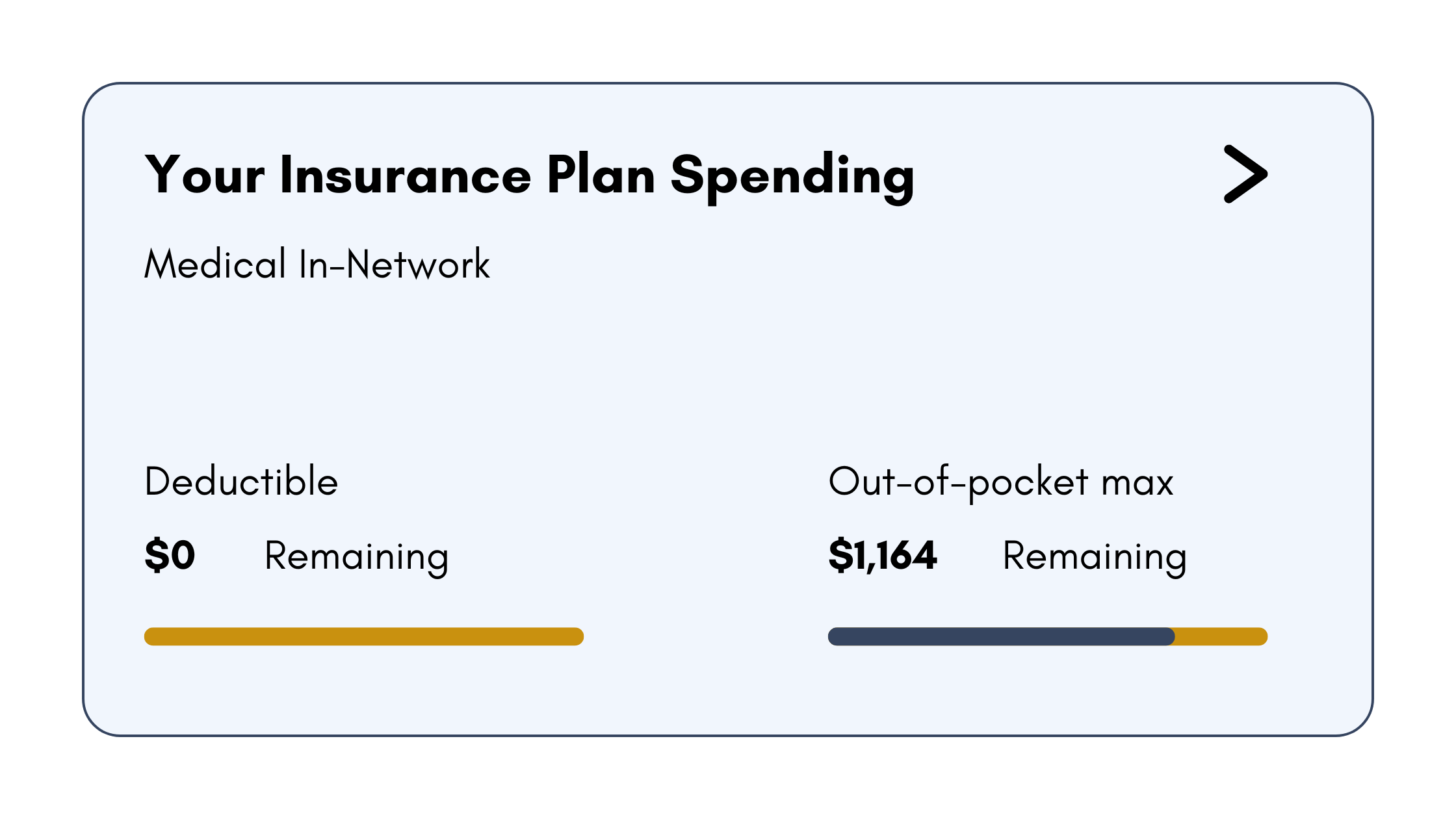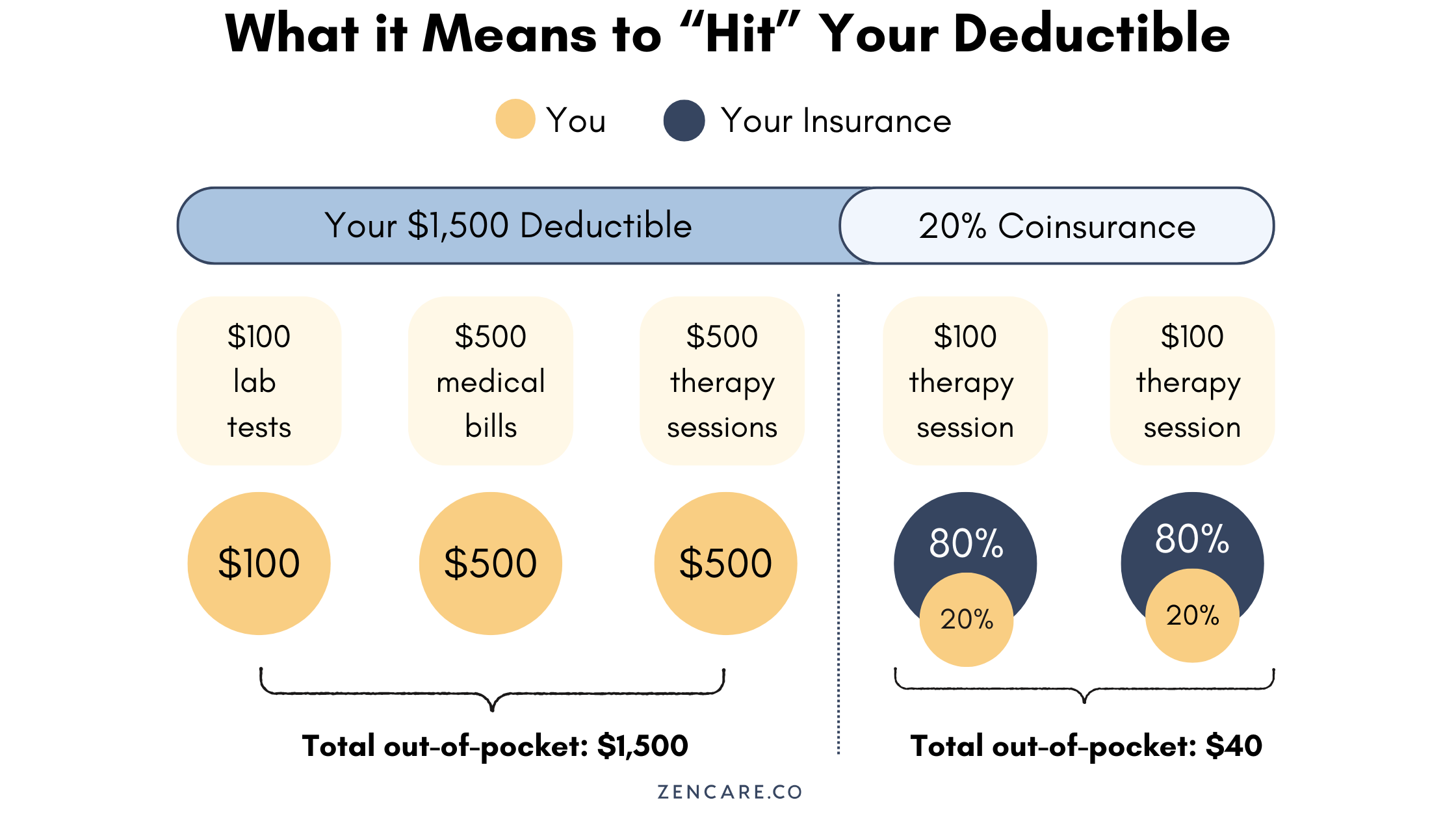Published on November 6, 2024 by Zencare Team. Clinically reviewed by Joanna Lovinger, LFMT and Natalie Asalgado, LCSW.
As the end of the year approaches, many folks find that they’ve finally hit their health insurance deductible after months of paying out-of-pocket for medical services, including therapy. This is a great opportunity to take advantage of your insurance benefits before the deductible resets in the new year. Once you've met your annual deductible, your insurance will start covering a larger portion of your therapy costs, often leaving you responsible for covering the coinsurance.
If you’re currently seeing a therapist and paying out-of-pocket or you have a high copay, hitting your deductible is a great nudge for you to schedule additional therapy sessions during this time and can help you maximize your insurance coverage. This is a great opportunity to focus on your mental health while reducing your out-of-pocket expenses.
TL;DR: You hit your deductible? Rack up those therapy sessions for much less out-of-pocket spend.
Therapy is an essential component of medical care, helping you manage mental health conditions, improve well-being, and address emotional challenges. Your "deductible" — plays a significant role in determining how much you pay out-of-pocket before your insurance coverage kicks in. We'll break down what it means to hit your deductible and how that impacts your therapy costs, helping you navigate your health insurance plan to make the most of your benefits before you celebrate the New Year.

Understanding Health Insurance Deductibles
What is a Health Insurance Deductible?
A health insurance deductible is the amount of money you must pay out of pocket for covered medical services, including therapy, before your insurance begins to share the costs. Think of it as a threshold that needs to be met each year. For example, if your deductible is $1,500, you’ll need to pay for your medical costs, including therapy sessions, up to that amount. After hitting the deductible, your insurance will start covering a portion of your expenses.
Note that for some insurance plans, there can be an in-network deductible and an out-of-network deductible. If you’re seeing a therapist who is in-network but you’re still paying quite a bit each session, hitting your in-network deductible could bring your session costs down. If you’re seeing a therapist out-of-network and you hit your in-network deductible, what you pay for therapy won’t be affected. You’ll have to hit your out-of-network deductible for those benefits to kick in for that out-of-network therapist.
Example: Imagine you go to therapy and the cost per session is $150. If your deductible is $1,500, you’ll pay for the sessions out-of-pocket, along with other medical costs like MRIs, surgery, lab tests or other medical bills until you’ve spent $1,500. Once you’ve paid your full deductible of $1,500, your insurance company will start covering a portion of the therapy costs, often requiring you to pay only a small percentage (known as coinsurance).

Keep in mind that not all payments count as “deductible expenses”. There are three major costs that don’t count towards your annual deductible:
- Copayments: The fee you pay at every medical session, including therapy.
- Premium: The monthly payment made to a health insurance company for health care coverage. If you get your insurance through your employer, this premium is likely automatically taken out of your paycheck.
- Payment for services not covered by your plan: Services like acupuncture, cosmetic procedures, fertility treatments are not typically ever covered by insurance companies.
Annual Deductible vs. Other Out-of-Pocket Expenses
Beyond your individual deductible, there are additional costs like coinsurance (a percentage of the bill you’re responsible for even after meeting your deductible) and the out-of-pocket maximum — the most you'll have to pay in a year. Once you hit the out-of-pocket maximum, your insurance will cover 100% of your medical expenses, including therapy, for the rest of the year. Say you hit your $1,500 deductible and continue paying medical expenses like prescriptions, the coinsurance fee on your therapy sessions etc. — those expenses go towards fulfilling your out-of-pocket maximum. And if you hit your out-of-pocket maximum before the end of the year, any other medical expense will be fully covered by insurance.
What Happens When You Hit Your Deductible?
Impact on Therapy Costs After Hitting the Deductible
Once you hit your deductible, your therapy costs will be significantly reduced because your insurance will start paying a portion of the bill. At this point, you’ll transition from paying for the full session cost out of pocket to paying only a portion through coinsurance.
Coinsurance and Insurance Coverage
Coinsurance is the percentage of costs you're responsible for after you meet your deductible. For example, if your coinsurance amount is 20%, and therapy costs $150 per session, after you hit your deductible, you will only pay $30 per session (20% of $150), and your insurance will cover the remaining $120.
You may want to have a conversation with your therapist to let them know you’ve hit your deductible and you’d like to have more frequent sessions before the end of the year. This is also a great time to check what your coinsurance will be for each session so you can prepare ahead of time and get yourself scheduled for those sessions.
Factors Affecting Your Deductible Amount and How Fast You Hit It
High Deductible Health Plan (HDHP)
A High Deductible Health Plan (HDHP) has a larger deductible but lower monthly premiums. This type of plan might be attractive if you're generally healthy or don’t need frequent medical services, but it can also make upfront therapy costs higher until you hit the deductible. The trade-off is lower premiums, but the risk is that you'll pay more out of pocket before your insurance starts contributing.
Pros: Lower monthly premiums.
Cons: Higher out-of-pocket costs until the deductible is met.
This plan can be a good option for those who are seeking therapy only occasionally or who can manage the upfront costs and prefer lower premiums.
Low Deductible Plans
On the other hand, a Low Deductible Plan offers faster access to insurance coverage because you’ll meet your deductible sooner. These plans often come with higher premiums but lower out-of-pocket costs for therapy services. If you attend therapy regularly, a low deductible plan may save you money overall, as your insurance starts contributing after fewer sessions.
Benefits: Lower out-of-pocket costs and quicker insurance coverage for therapy services.
Drawback: Higher premiums every month.
Maximizing Your Insurance Coverage for Therapy
How to Manage Medical Costs with a Health Insurance Plan
Here are some strategies for keeping your out-of-pocket therapy costs manageable:
- Utilize preventive services that may be covered before hitting your deductible.
- Keep track of your therapy expenses throughout the year to know when you’re close to meeting your deductible.
- If your health insurance plan has an app, the app’s dashboard will likely also share your progress towards your deductible.
- Review your insurance plan’s Summary of Benefits to understand how much you’re paying toward your deductible and coinsurance.
Understanding Your Insurance Claim Process
Filing an insurance claim can sometimes be complex, but working with your therapist’s office to ensure services are billed correctly is essential. Make sure you:
- Understand your insurance claim process.
- Ensure that therapy services are coded correctly so they count toward your deductible and are reimbursed by your insurance.
You can also use an app like Reimbursify to help you submit claims and keep track of all your out-of-pocket expenses.
Planning for Therapy Costs Next Year
Budgeting for Your Deductible
Planning ahead for your therapy costs in the upcoming year is crucial. If you know how often you attend therapy and the cost per session, you can better estimate how long it will take to meet your deductible and what your out-of-pocket costs will be after that.
Tracking Your Calendar Year Medical Expenses
Keeping track of your medical expenses throughout the year helps you stay on top of how close you are to hitting your deductible. By knowing this, you can plan when to schedule therapy appointments for maximum insurance coverage.
Choosing a New Plan at Open Enrollment
If you’re not satisfied with your current health insurance plan through your employer, open enrollment is the perfect opportunity to make changes. During this period, you can review different plan options and select one that better fits your current needs and lifestyle. Whether you’re looking for a lower deductible, higher deductible, better coverage for specific health care services, or access to a broader network of providers, open enrollment allows you to tailor your healthcare coverage to what matters most to you now.
Some therapists may also be open to reviewing possible plan options with their clients to ensure they’re getting a plan that works for them and their treatment.
Conclusion
Understanding what it means to hit your deductible and how it impacts therapy costs can help you make informed decisions about your health insurance plan. Be sure to regularly review your health insurance coverage and consult your provider to ensure you’re maximizing your benefits, especially for therapy services.
Later in the year around fall is when most people begin hitting their deductible, which is a great time to start increasing your therapy sessions and maximizing your benefits.
FAQ
What is a health insurance deductible for therapy?
A deductible is the amount you must pay for therapy before your insurance starts to cover a portion of the costs. Remember that for some insurance plans, there can be an in-network deductible and an out-of-network deductible. If you’re seeing a therapist who is in-network but you’re still paying quite a bit each session, hitting your in-network deductible could bring your session costs down. If you’re seeing a therapist out-of-network, you’ll have to hit your out-of-network deductible for those session costs to come down. So when you’re tracking your deductibles, make sure you’re looking at the right one.
How does hitting my deductible affect therapy costs?
Once you hit your deductible, your insurance will start covering part of the cost, leaving you responsible for only a percentage (coinsurance).
What is the difference between a high deductible and low deductible health plan?
The difference is in the monthly premium. A high deductible plan has a lower premium but higher upfront costs, while a low deductible plan offers quicker coverage but a higher premium.
What should I consider when choosing a health plan for therapy?
Consider how frequently you attend therapy, your budget for out-of-pocket costs, your FSA or HSA contributions, and whether therapy is covered under preventive services by your insurance provider.
